First organic bananas from Tenerife, the 20 banana letters
First organic bananas from Tenerife, the 20 banana letters: difference between regular cultivation and organic bananas, firsthand. Health value, ripeness, etc.
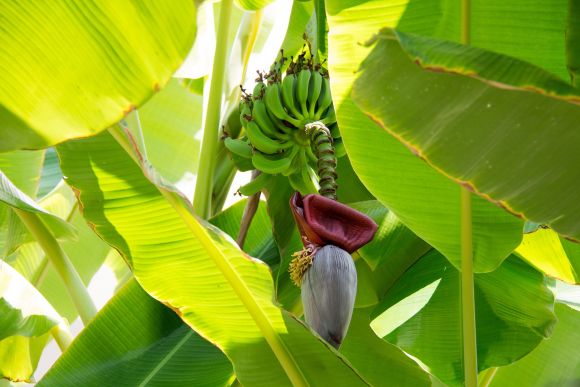
Table of contents
- 1. Why cultivate bananas on Tenerife?
- 2. The 20 banana letters
- 2.1. The beginning and contact opportunities
- 2.2. Organic farming as compared to conventional production
- 2.3. But the banana is protected by the peel!
- 2.4. Our nutritional requirements — not 90% bananas
- 2.5. Where did bananas originally come from and what is their story?
- 2.6. Information about banana plants and their reproduction without seeds
- 2.7. The work required to maintain good bananas
- 2.8. The difference between fully mature and peak ripeness
- 2.9. Transport under the right conditions and careful handling
- 2.10. Our own packing center — 1986
- 2.11. The nutritional value of bananas
- 2.12. A closer look at the substances contained in bananas
- 2.13. Do bananas have healing properties?
- 2.14. Specific results showing the value of bananas
- 2.15. Recipes with bananas
- 2.16. Erb Muesli — recipe with sprouted grains
- 2.17. More information about the basic recipe
- 2.18. Ingredients in the classic Erb Muesli
- 2.19. How to we maintain our ideal weight and what is this?
- 2.20. Dessert bananas, plantains, and degrees of ripeness

Perhaps the Canarian bananas from Tenerife have an especially flavorful taste thanks to the volcanic soil. The cultivar Dwarf Cavendish is more wind resistant as compared to, for example, Grand Nain bananas.
For me, these warnings were very problematic as I was a strict vegan raw foodist (Types of Raw Food Diets) and was trying to cure a deadly, practically incurable sickness by radically changing my diet. See my experience with disease.
For various reasons, I chose bananas (dessert bananas) to serve as the important basis for my Erb Muesli. As I am a critical person and either know things or don’t know and want to find out, I decided to do in-depth research on the subject.
Vegan raw food was practically unheard of in the late 1970s. When I told people about how I was changing my diet, they only smiled. And I understood this because before I would have smiled inside as well and pitied the person who had shared this news with me.
1. Why cultivate bananas on Tenerife?
At that time, there was very little variety when it came to fruit in Switzerland and even in the middle and northern areas of Europe. And as a vegan raw foodist, your diet is based on vegetables, fruit, and nuts of all kinds. Subtropical and tropical fruits (exotic fruits) provide for great variety in a vegan raw diet. And that’s why I wanted to learn to grow my own fruits and vegetables, and why I wanted to do this in a climate that would even allow for certain types of tropical fruits to flourish. But I also wanted to live in the same cultural area, specifically in the European cultural region, and I didn’t want the travel time from Switzerland to this place to be very long.
Tenerife is the largest of the Canary Islands in the Atlantic Ocean. Thanks to Mount Teide (12,198 ft or 3,718 m), it has a range of very different climate zones. An especially tasty variety of bananas grow there. For these reasons and others, I decided to move to Santa Ursula de Tenerife.
My organic finca SA in Santa Ursula supplied Migros, Switzerland’s largest retail company
For at least three years, my organic finca SA in Santa Ursula supplied Migros, Switzerland’s largest retail company, with what are called transitional products (Bio Suisse). These are organically grown fruits that are sold as conventional agriculture products.
This is good for many reasons. For example, residues of pollutants from previous production remain in the soil, and it requires a certain amount of time for the land to be free of these. Some of these can be persistent organic pollutants.
There were soon other organic banana suppliers, for example, from Israel, but it wasn’t until organic bananas from Central America came on the market that we were no longer able to offer competitive prices, and I had to give up the entire production.
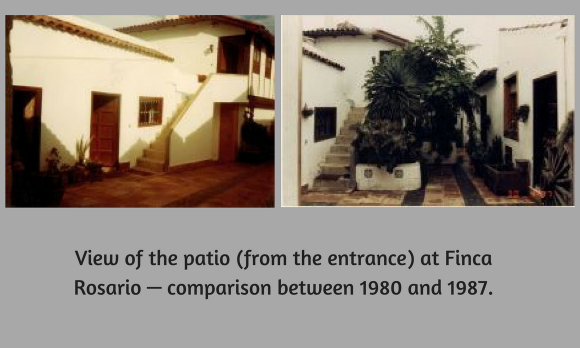
2. The 20 banana letters
Below, you can read the “20 banana letters”; unfortunately, the letters did not include the date they were written. They are actually circular letters. With the time, we rotated the letters so that after 20 weeks, the customers received the first letter again. We were able to scan the letters and upload them to the site using OCR recognition software. However, it is possible that errors occurred in the process. I chose not to update the text, but instead to leave the statements as they were made at the time, before the Internet existed. I did, however, add the links and terms in curly brackets.
2.1. The beginning and contact opportunities
Dear Customer,
Since the beginning of 1981, we have been growing organic bananas. We first took care of about only 100 plants in our large garden because we wanted to see if it was possible to switch bananas that had been treated with pesticides and chemicals over to organic cultivation. All of the experts we consulted had their doubts.
But our little experiment worked, and in June 1982, we purchased several acres of bananas through our newly founded organic finca SA and then switched them over to organic growing conditions.
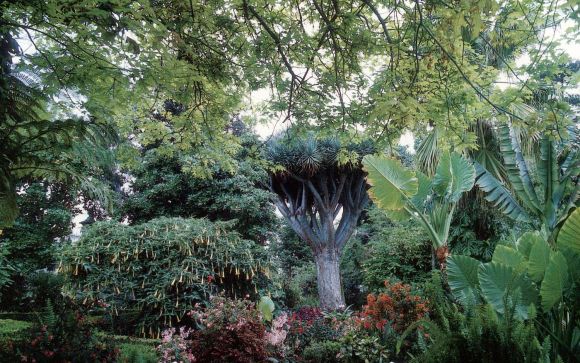
I would like to share firsthand with you how our products grow and why
You might ask why I am sharing this with you. We have had many customers visit us at our finca (span. for farm), and we can tell that there is often a lack of clarity when it comes to growing methods, transport, ripeness points for harvest and consumption, and the banana’s significant health benefits.
We have put a lot of effort into building our business up over the last several years, and now that it is beginning to bring us joy, we want to keep it working well.
In the future, we plan to regularly include “letters” with the bananas (and later perhaps also avocados) that contain practical information. We would ask the retailers to distribute these or hang them up in their stores, and the letters would be rotated regularly. The entire collection of letters would provide an overview of our business and products, which so far include bananas, dried bananas, and avocados—all of which are from certified organic production.
Our main topics will be organic production (organic farming), why and how, comparisons to conventional farming, information about us, current news, eating bananas, and, of course, recipes.
Contact information
Tenerife is becoming an increasingly popular tourist destination, and at certain times of the year we have visitors almost daily who are interested in our work. People sometimes mistakenly assume that we have lodging for visitors.
Although we don’t offer this, we would be happy to arrange a tour of the plantation and large garden, where about 50 different types of fruit grow. At the moment, we are only able to offer tours one day a week, currently on Tuesdays at 10 a.m. We ask that you call in advance if you are interested in participating. In most cases, the tours are led by our agriculture engineer Annette Pott, or in the garden by my partner Margot.
We can only answer your letters personally in exceptional cases, but we will answer questions of a general nature in these letters. Even if you don’t receive a direct answer, please know that we have read and discussed your letters.
Please contact us if you are interested in doing an agricultural internship in our garden for a minimum of six months. Internships on the plantation are not possible as highly specialized work takes place there, and we are not able to obtain permission for these from the government.
We didn’t realize that our work would generate such great interest and hope we can answer your questions through this “new medium.”
I wish all of you good health and happiness!, Ernst Erb

I will not include the greeting or the closing in the following letters as they are always the same.
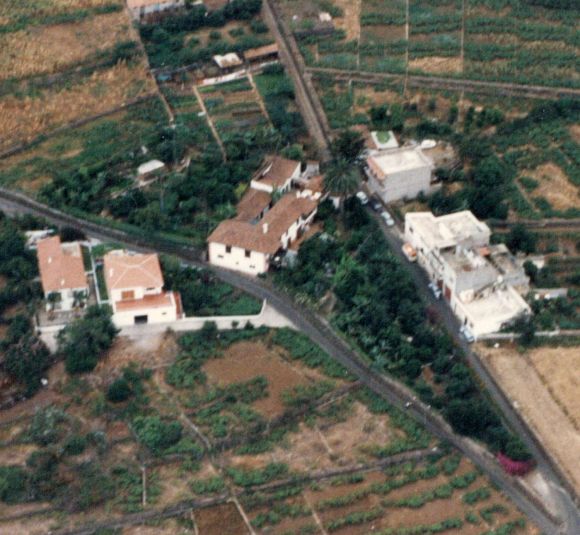
2.2. Organic farming as compared to conventional production
Well-meaning, reformist groups have often vilified bananas as food. As an advocate of organic foods, I investigated this question independently using my own resources. The reason. Given my health, I had moved to a climate zone where many kinds of fruits and vegetables grow all year long — including bananas. And before this, I had created a muesli cereal that contained only natural ingredients, and bananas were one of the main ingredients.
In cooperation with the ministry of agriculture, a poster was created that recommended the following products:
| Against white louse | Organophosphates such as dimethoate, diazinon, fenitrothion ("Folithi.." Bayer), "malathi..", and chlorpyrifos | |
| Against wood worms | Aldrin, diazinon, or foxin (Volaton) | |
| Against thrips | "Linda.." (!), fenitrothion, or dimethoate | |
| Against red spiders | Organochloride substances such as dicofol or tetradifon | |
| Against nematodes | Dazomet (DBCP) | |
| As herbicides (weed killers) | Animotriazole {amitrol} + Diuron {DCMU}, paraquat, and others |
These substances are applied in the form of fertilizer. The entire situation made me decide to search for a closed and natural cycle (nutrient cycle) for bananas.
A closed and natural cycle for bananas
The existence of many empty cow stalls and old x were confirmation that they had previously had two cows per hectare (2.5 acres) of bananas in order to generate the necessary biomass. The stalls were filled with pine needles, which were removed when there was danger of fire, and at certain times, with Erica {heather}.
I was lucky to meet and work with Manolito Exposito, a young Canarian agriculture engineer {agricultural engineering}, whose family brought more than 30 acres (12 hectares) of land to our joint venture.
As the amount of work grew, agriculture engineer Annette Pott also joined our company {agriculture science}.
For several years, we conducted a series of meticulous experiments that involved collecting the data on hundreds of plants each week and saving this on the computer (PC). We needed quite a bit of capital and time to convert all of the soil for our plants.
Before we discuss the details, here is an overview of our current production methods and the results:
- We use pine needles and branches from tree heathers as bedding for steer, cow, and horse stalls. Both of these materials can be found in a natural area at more than 3'280 feet (1000 meters) above sea level.
- At the beginning, we also got new soil here to provide the banana plants with a new environment. Their roots weren’t yet very deep, and they needed all the support they could get. With this step, we were able to neutralize the nematodes {round worms}.
- The cows and steers receive pseudostems (rolled bases of leaves), storage organs (rhizome), and parts of the harvested bananas as well as feed that we produce ourselves, which is also fed to the horses.
Thanks to this closed biological cycle, we can grow bananas without using any fertilizer at all.

We now have rich soil life {soil biota}, whereas the soil of other plantations contain absolutely no worms or soil biota. Now that we have healthy plants, we have fewer problems with insects and do quite well using only natural means. We will report more on this in the next letter.
2.3. But the banana is protected by the peel!
In letter 2, we mentioned insecticides, nematicides, herbicides, and fertilizers, which are all used in the conventional production of bananas. It is important to note that these chemicals are expensive and are therefore used as little as possible.
In Central America, where most of the bananas consumed in Europe are grown, the chemicals are often applied by crop dusters to ensure that the application is even.
It’s important to share this here as well.
After we purchased the first piece of land and before converting to organic production, we had several analyses done in Switzerland. The results from April 19, 1982, did not show any phenylurea pesticides, and the analysis of organochlorine residues showed a trace of HCB (hexachlorobenzene, less than 0.1 ppb), 1 ppb alpha-HCH, and 3 ppb "linda.." {persistent organic pollutants}.
The first years were difficult
Perhaps we were particularly lucky with the soil, which we later even renewed by adding numerous truckloads of “virgin soil.” We would be interested in having more testing done on our bananas and also in seeing test results from other bananas. We would be grateful for any tips or advice you might have.
 | The first years were difficult, and we had serious losses as it wasn’t possible to transport the bananas to Europe in such small quantities. As we will see, there are a variety of reasons why Canarian bananas are more expensive than bananas from Central America. Organic production also requires more work, and the yield is smaller than bananas “driven” by fertilizers. However, the nutrient cycle described here strengthened our plants so much that we could normally use plant-based broths to fight insects and only had to use tobacco in exceptional cases. |
Since customs doesn’t let any fruit through that has traces of insect infestation, we lost some bananas. Although white louse {mealybugs} and “red spiders” {red spider mites} only suck on the surface, they leave spots on the peel.
We now avoid such losses by using these bananas to produce dried bananas for muesli manufacturers. And we also dry bananas that were ripe early to eat as snacks. I will discuss gentle drying methods later.
We were able to successfully convert three banana farms. Two belong to Germans who have moved here. Converting a farm on the western side of the island was not entirely successful, and the owner decided to start spraying it again. It seems that there are fewer problems with insects on the north side of the island thanks to the colder climate — the island is separated by a mountain that is about 12,195 ft high (3717 m).
However, the yields are significantly smaller than in the south or west of island, and minimal in comparison to the large yields produced in the “banana countries.”
We have not yet been able to meet even half of the demand of our buyer. But rest assured, we don’t plan to revert back to conventional production as some have done and thank you for your understanding that we still the need some time to be able to completely meet the demand.
2.4. Our nutritional requirements — not 90% bananas
People today have more than a hundred different types of fruit to choose from. In our garden, we have about 50 different types, including bananas. As the “queen of the fruits,” I would choose mangos, or lychees {litchi}, papayas, cherimoyas — or an especially tasty apple {cultivated apples}. Many fruits, for example, papayas also have special healing properties.
But when the goal is a healthy diet and getting the necessary nutrients, then I would choose the banana over all other fruits.
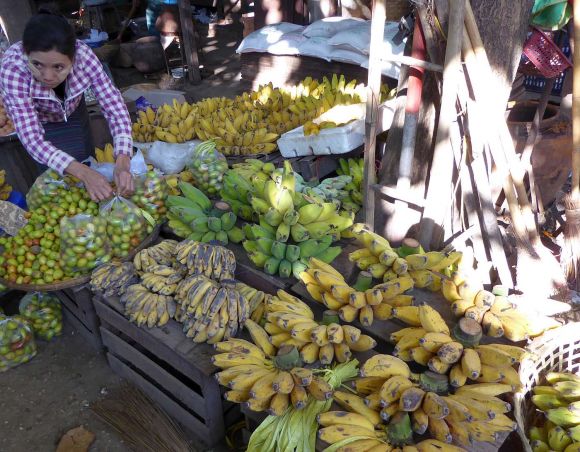
In some regions in southern Asia and Africa, bananas make up 90% of the diet. However, there they mainly eat cooking plantains and not the dessert bananas we are familiar with. Some nomadic tribes also eat a large proportion of dates, but no fruit can compare with bananas when it comes to amount or proportion. You can see from my initial explanations that bananas are excellent foods; they can be eaten exclusively as the “first and last” fruit.
Our nutritional requirements
Along with the air we breathe and physical activity, our body needs water, calories in the form of carbohydrates or fats, essential proteins for building, dietary fiber (roughage) to support our digestion, specific elements {e.g., trace elements}, vitamins, enzymes, and hormones. Alcohol {ethanol} comes under the category of calories, but is unnecessary. Proteins can also serve as a source of calories.
Even 20 years ago, it was said that we needed about 100 essential nutrients. But the newest scientific books now cite about 50 essential nutrients (Ernährungslehre und Diäthetik, 6 Handbücher [Nutrition science and dietetics, 6 volumes], Thieme Verlag).
Without these, we would show deficiency symptoms in the long term or in the worst case, we would die.
However, our body has a large buffer so that even longer (up to six weeks) periods of less than ideal nutrition or fasting don’t necessarily lead to problems. There is also a large difference between eating raw and cooked foods, and today an increasing number of experts are recommending that we eat a large proportion of raw foods.
The advantage of raw foods
One advantage of raw foods, which are rich in fiber, is that it takes an average of 20–48 hours for them to be digested, whereas “western foods” take 44–144 hours (Wissenschaftliche Tabellen (Scientific tables), Ciba-Geigy, volume 2).
However, you shouldn’t count on this being the perfect solution; digestion is only ideal when it takes place without gas {flatulence} and putrefaction.
But most people consume less than 40–45 % carbohydrates, which over time can lead to metabolic disorders. Fruit, bananas in particular, helps to improve digestion. According to Dr. X. Mayr, it is important to avoid fruit in the evenings.
Bananas can help to relieve constipation and also diarrhea, whereby the ripeness {ripening} of the bananas makes a big difference.
In one of the next letters, you can read about the extent that the substances contained in bananas cover our nutritional requirements. Until the beginning of the 1960s, bananas were used as a means of treatment in many hospitals.
2.5. Where did bananas originally come from and what is their story?
Bananas were grown in India as early as 327 BCE; the reports from soldiers of Alexander the Great showed that they were quite impressed. Thanks to Arabian traders, bananas were soon being grown in Eastern Africa, and in 1482 (or around 1510) Portuguese sailors brought them from Guinea to the Canary Islands and in 1516, from there to the Caribbean. In the sixteenth centuries, bananas were available in many areas near the equator.
In 1848, the first banana shipments were sent from Madeira to England and in 1850, from Panama to the United States.
Starting in 1884, with the construction of a harbor for steamboats, the English brought tourists to the Canary Islands and bananas from here back to England.
Bananas were first imported to Germany in 1892 by the Hamburg fruit merchant Richard Lehmann and then in 1902 by the fruit dealer Gustav Scipio, who was from Bremen.
The trade of bananas stopped in 1936 because of the Spanish Civil War and Second World War. Up until the beginning of the 1960s, Canarian bananas were imported to Europe in a limited scope, but had to compete with the large bananas from Central America. They were soon pushed out of the market by these cheaper fruits. But Spain doesn’t import any type of bananas other than Canarian bananas.
Bananas are one of the first fruits that humans domesticated
The origin and history of this most commonly eaten fruit on earth are fascinating. Bananas are one of the first fruits that humans domesticated.
We find them on many cultural objects (vases, frescos, and everyday objects) and in many legends of the ancient Chinese, Greeks, and Romans.
The musaceae family was named after Antonio Musa, the physician for the first Roman emperor Octavius Augustus (63 BCE–14 CE). The genus musa includes about 50–60 species and was originally found only in the Old World. T
he center of origin of our bananas musa acuminata (type A) lies in Malaysia/Indonesia and that of musa balbisiana (type B) around the Brahmaputra River (Bangladesh).
The plant itself is in the group of perennial herbaceous plants whose pseudostems are formed from overlapping leaf sheaths.
The tallest herbaceous perennial is likely musa ingens, which is about 50 ft high (15 m) (Heinz Brücher, Tropische Nutzpflanzen [Tropical domesticated plants, Springer Verlag).
Dessert bananas {Musa x paradisiaca} were originally classified into two species and have a triploid genome, or three complete sets of chromosomes. The fruit develops without fertilization via parthenogenesis.
Banana varieties achieved through pedigree breeding are male-sterile and seedless. The plants undergo a type of asexual reproduction called vegetative reproduction.
Natural crossings of both varieties include, for example, Latundan bananas (type AB, also called silk bananas and apple bananas, and Fr. figue pomme), cooking bananas (type ABB, also called apple plantains, and Span.: majoncho), and Malaysian cooking bananas (type ABBB, pisang batu).
The name “banana” comes from the Arabic and means “finger.”
All common types of bananas originate from the species eumusa.
There is also a species called australimusa that has its center of origin on the Maluku Islands. These cooking bananas are long and thin bananas used in Tahiti that are called Fe'i bananas.
Fiber bananas (Musa textilis, called Abacá or Manila hemp) are in the same seedless species (Brigitte Kranz, Das grosse Buch der Früchte [The large book of fruits], Südwestverlag).
Strelitzia (bird of paradise flowers) are also in the musaceae family.
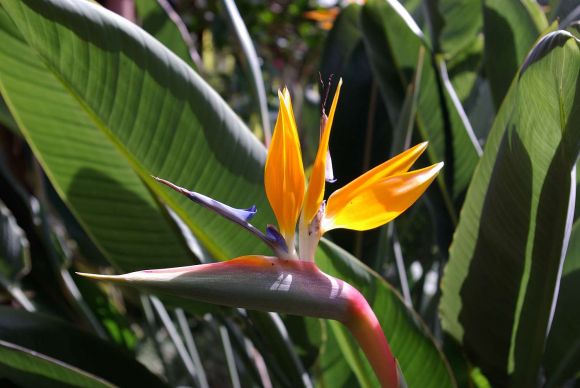
We also grew Streliziea reginae (bird of paradise or crane flowers). This photo shows not only the blossom, but also the close resemblance the leaves have with bananas. According to Wikipedia, the plant comes from South Africa, but several varieties are also found in Indonesia/Malaysia. I have the feeling that Strelitzia only later migrated to Africa.
2.6. Information about banana plants and their reproduction without seeds
Hundreds of natural banana clones, most of which originate from sprout mutations are very similar to the Cavendish bananas, which most likely originated from bud mutants. We distinguish between:
- the “big brand” bananas with varieties such as: Gros Michel (Big Mike), Valerie (a cross of Gros Michel), and Giant Cavendish or
grande naine
(large dwarf) - and, on the other side, our small Dwarf Cavendish (nain or pequeña enana). This small banana is better able to adapt to various climates and grows well in North Africa, Israel, Madeira, and on the Canary Islands {See also: List of banana cultivars}.
The Dwarf Cavendish and how bananas grow
The Dwarf Cavendish grows to be about 10 feet high (2 meters) and is therefore more wind resistant than the Giant Cavendish (on average about 2 feet taller (70 cm)) and the Gros Michel (19–26 feet high (6–8 meters)).
Bananas grow out of a bulbous root stock (rhizome, corm), which sends out absorbing roots (Haustorium) horizontally near the surface.
A farm here consists of 1'400 to 2'000 plants like this per hectare (2.5 acres). In the north of Tenerife, we can only plant the smaller number, but the bananas have more flavor than those grown on the southern part of the island.
Shoots (suckers) grow out of the rhizome, and one of these is left to grow. Propagation involves removing a shoot and transplanting this, but the rhizome grows shoots practically “without end,” making propagation unnecessary.
The leaves grow out of the middle of the pseudostem; flowers appear, and then unfertilized fruit form and hang down like an “arm.”
If the arm with the many “banana hands” is cut off, it takes 12 to 16 months here until the fruit of the next shoot (daughter) is ready to harvest. In Central America, this process is a couple of months quicker.
Bananas are harvested year-round as each plant has its own cycle.
However, the bananas tend to be ripe in certain months in each climate zone, and about two-thirds of the fruit is actually cut in three months of the year.
In English, it is typical to use female designations, but in German the equivalent male designations are generally used (grandfather, father, and son).
In one of the next letters, you can read why some of the work on a banana plantation has to be done by men.

2.7. The work required to maintain good bananas
The “healthiest fruit in the world” also demands a “healthy amount” of work before it can be harvested. We will now observe a shoot as it grows:
Only one of the shoots is cultivated and allowed to grow. With each new generation, the shoot moves about 20 inches (50 cm) further out. It shouldn’t get too close to its “neighbors,” and shoots cannot be allowed to follow the daughter too soon or too late. Only a few workers have the eye and training when it comes to removing undesirable shoots.
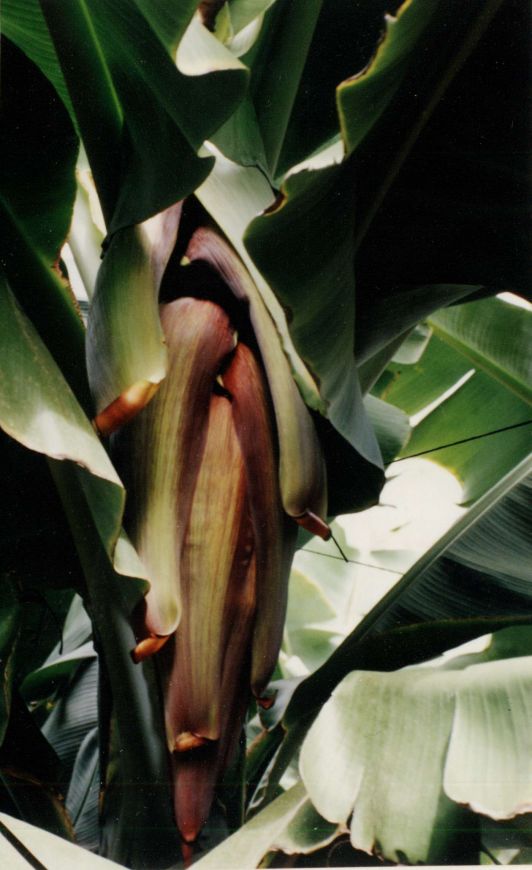 | The last shoot appears with the large brownish-red “flower.” The bananas grow underneath the leaves covering the flower. Some of the large banana leaves have to be removed to give the bananas enough space to grow. After about two weeks, the individual flowers at the end of each banana are plucked off and the leaves covering these are removed so that Taladro moths can’t lay any eggs {probably moths from the genus Zeuzera, perhaps Zeuzera pyrina}. |
After several more weeks, the arm with the young bananas is supported by a stick extending from the stem, which allows the bananas to grow freely.
Mature bananas
At about the same time, the “hermaphrodites” between the “male flowers” and the growing bananas are removed so that the juices can flow freely in the stalk. The “male flowers” are then removed several weeks later.
If a plant is hanging too low because of the weight of the bananas, it is tethered from the other side. A plastic sack is often placed over the arm and left partially open. This protects the bananas from insects and provides more warmth for the bananas to grow. And this is also the reason why some greenhouses are made entirely of plastic.
About six months after blooming, the arm can be harvested with its green, but mature bananas.
Since we so often hear people repeat inaccurate information about cutting green bananas, I will discuss this topic in a future letter in more detail and explain how we are actually harvesting at an ideal time.
The last work in the cycle of an individual plant is to cut off the old pseudostem. We wait several weeks to do this so that the nutrients can flow back into the rhizome.
We also have some other general work to take care of: we get about 14 to 20 inches (350 to 500 mm) of rainfall per year here. However, a banana plant requires 1'585 gallons (6'000 liters) of water, and we therefore have to water twice a week.
Watering
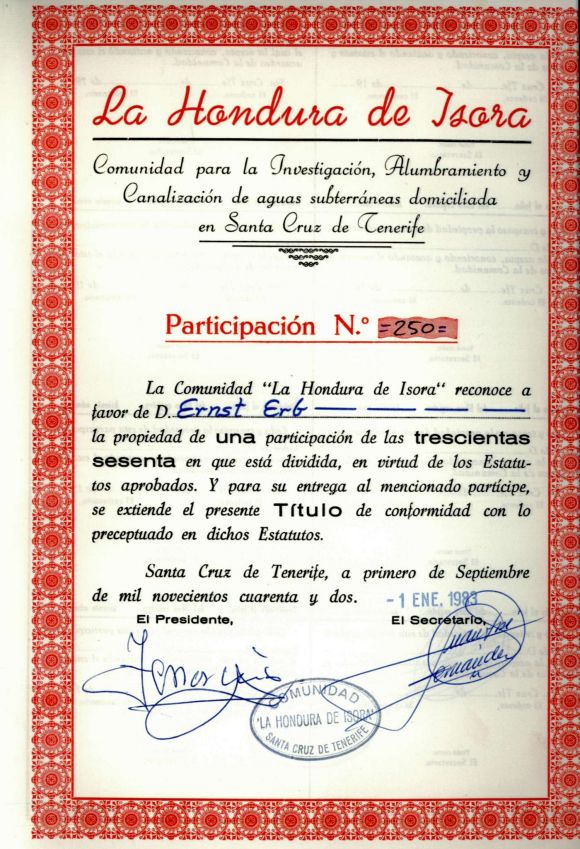 | Many places do this via small open channels that can be closed, for example, with a piece of pseudostem. Since this older system uses too much water, we set up a sprinkler system that includes a sprinkler nozzle on each plant. We have a rainy season here twice a year — February/March and October/November — that often brings storms with it. We secure the plants with twine and iron wire to prepare for these. |
At least every two years, we apply a mulch to the soil. This is an intensive process that often requires cultivating the land by hoeing. This work is done in the “winter” when the absorbing roots are inactive. Starting in March, new roots begin to grow. The plantation also has to be weeded by hand, although we do tolerate a certain amount of weeds because of time limitations.
2.8. The difference between fully mature and peak ripeness
There are several negative points that people often wrongly believe to be true of bananas, for example, those that deal with harvesting when green and the ripening process. To be honest, I know that, out of ignorance, I have also incorrectly repeated some things commonly believed to be true in the past — even the idea of “clean nuclear power generation”, that is until I read the book "Friedlich in die Katastrophe" (Peacefully into the catastrophe) by Holger Strohm. I was just very upset that the coal and oil refineries were producing so many toxins.
Back to the topic of fully mature bananas. There are, of course, bananas and other tropical fruits that are harvested too early. But since our bananas don’t have to be transported very far, this isn’t necessary. We cut the bananas when they are “tree-ripe,” but still green — we also do this with the bananas we eat.
A good example of this is the avocado
The Hass avocado, for example, can remain on the tree almost a year before it is overripe and falls off. But even though it is “ripe,” it no longer tastes good. It has a mealy, fatty consistency and an off-taste. The avocado is still hard two months before falling off, but it won’t develop a flavorful taste because it was on the tree for too long.
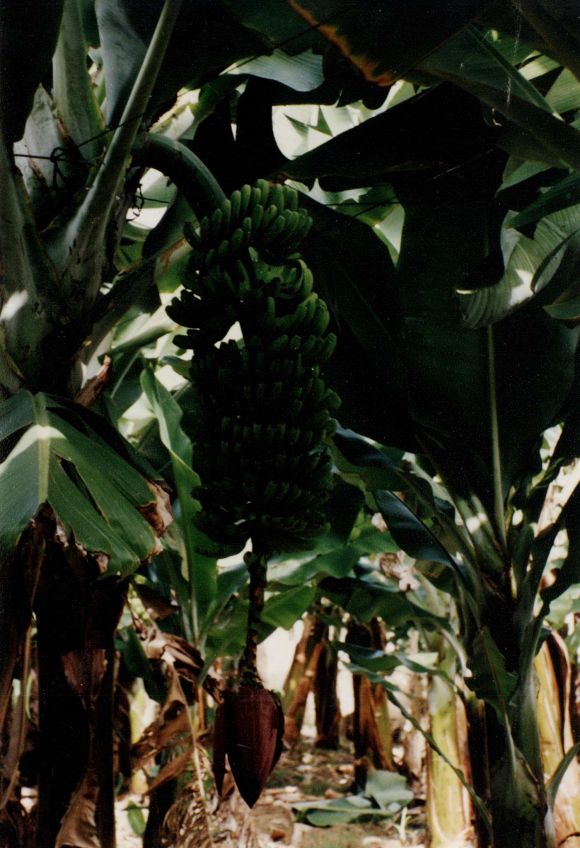 | If avocados are harvested too early, even after additional ripening, they won’t taste as good or contain the typical amount of fat. The situation is similar with bananas. If they are left on the banana plant too long, they will start to go bad. The peel will split, and the banana itself will be mealy instead of sweet. This is the reason why people who know more about bananas and live in an area where they grow cut their own bananas when they are green and let them ripen in a shady place. |
On the plant or hung up in a bunch, the individual hands don’t ripen at the same time, which makes it possible to eat from the bananas you pick for some time.
From the first ripe hand to the last, postripening can take from one to three weeks, depending on the temperature. It takes two to four weeks for the first hand to turn yellow and reach peak ripeness.
If you want to speed up the process, you can wrap a hand in newspaper with a ripe or overripe banana or with another fruit that produces ethylene gas.
Ripe tomatoes, apples, and pineapple produce a lot of ethylene gas and are therefore good choices. Speeding up ripening positively impacts the fruitiness of the bananas.
Carbide - to ripen a larger amount of fruit
In the past, if you had a larger amount of fruit that you needed to ripen at the same time, you would have used carbide (still used today on the Canary Islands) as your ethylene producer.
In production today, growers use 0.1 ppm ethylene and make sure that the temperature remains stable at 59–64°F (15–18°C); this way, the process only takes four to five days until all of the bananas have almost reached peak ripeness.
The bananas do have to be transported and sold.
2.9. Transport under the right conditions and careful handling
Bananas should be harvested when they are in a ripening stage where the first hands will begin to turn yellow after two to three weeks, if nothing is done to speed up the process.
Banana growers experience losses when the bananas weigh less, and customers because the peel weighs more.
Bananas shouldn’t be in transport to their country of destination for more than ten to twelve days
We can offer shorter transport times thanks to our relatively close location. And this is why the large producers have their packing centers for Europe on the coast of the Atlantic Ocean.
The bananas from Central America are transported with special, refrigerated banana ships {reefer ship}, which are normally painted entirely white so that less warmth from the sun is absorbed. Our bananas are also shipped by refrigerated transport. Bananas are the most delicate of all the fruits transported.
We ship our bananas in integral refrigerated containers, which are set to 53.5–59°F (12–15°C), depending on the season.
You wouldn’t believe it, but it once happened to us that a container was mistakenly set to 12–15 degrees Fahrenheit. When they arrived at their destination, they were frozen and black.
The transport of the bananas, in general, is something that gives us great cause for concern. In the winter, there are often storms, you can’t count on the departure and arrival times, and the temperatures often drop too low.
And distribution in the country of destination can also be difficult; in the spring, there are often strikes in Spain, and in the summer the bananas tend to ripen too quickly.
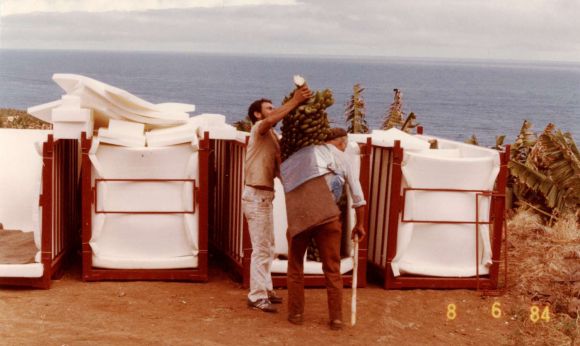
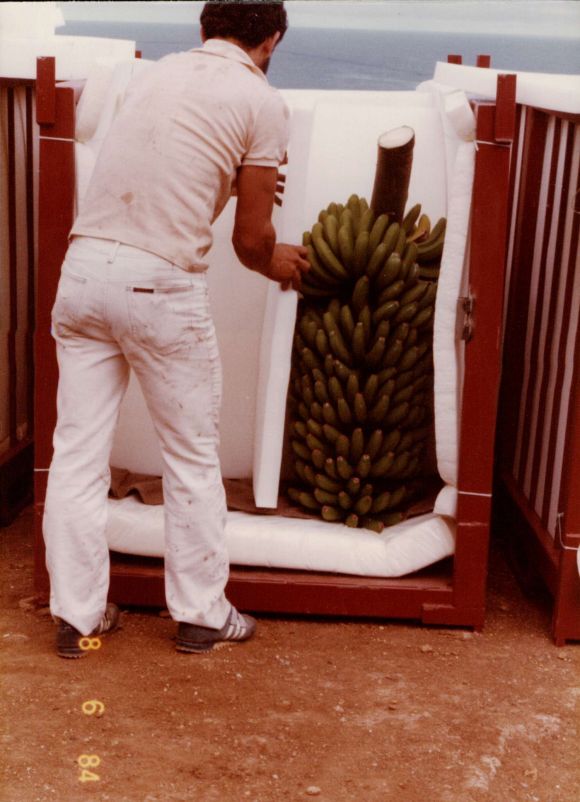 | These discolorations are often caused when the leaves of the banana plant brush against the bananas in the wind. When pickers harvest the bananas, they have to make sure not to pull the heavy arms over their belt. The arms can weigh anywhere between 44 and 88 pounds (20 to 40 kg). For the transport to the packing center, the arms are wrapped in wool blankets. |
It takes several trucks loaded with seven horizontal rows of bananas stacked on top of each other in each one. This is only possible because the Spaniards on the main land aren’t familiar with any other fruit. We constructed special cages for our organic bananas that are padded with foam rubber mats and place the arms individually in these. The truck has a special crane to collect the loaded cages on the finca (farm).
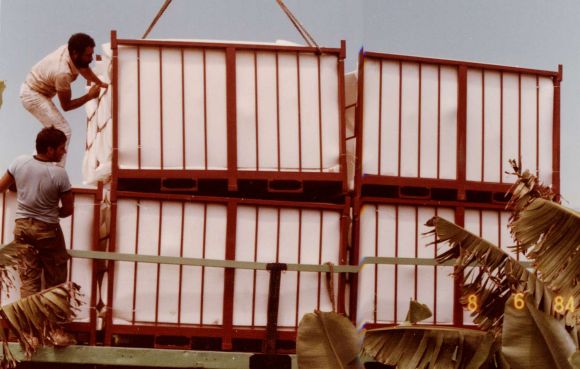
PS: Many types of fruit are not known in Europe because they can’t be transported or can only be transported by plane. The most extreme example I know of are mulberries, which you can’t buy in a store here. We eat them directly from the tree, with juice dripping down our fingers.
2.10. Our own packing center — 1986
In 1986, we were finally able to purchase our own packing center. We had previously had our own employees pack the bananas at various packing centers; since we were paying, we were either more or less accepted.
In contrast to Central America, the bananas are packed in boxes that weigh 26.5 pound boxes (12 kg) and not 39.5 pounds (18 kg). We also use thicker boxes, which are more expensive, as we determined that the bottom layers were receiving pressure from the sides because the boxes were being pushed in. This was an extra step that others in Spain or beyond weren’t taking.
We are the only packing facility here that goes to such lengths to improve the quality of the bananas. However, most of the bananas here headed for Spain are sorted into different size categories, something that we don’t do.
Improve the quality of the bananas
When we bring the arms (bunches) into our packing facility, they are taken out of the “cages” and hung directly on a continuous conveyor chain that passes through a stream of pure mountain water, washing away the majority of the dust and impurities from the bananas and cooling them off.
Arm by arm, a worker takes the fruit bunches and separates them into banana hands, which are then placed in fresh water. They float in the water and more dirt is removed. The workers then take the hands and cut off bananas that grew irregularly or are damaged and, where necessary, cut off some of the “crown.” This is what the stem of the banana is called, from which the bananas hang. It should be as large as possible so that the grocers can cut some off if the crown has begun to rot (crown rot). If this isn’t done, the bananas will gradually turn black.
A conveyor belt then takes the carefully processed, blemish-free bananas through the water jets a last time. This station sprays them with water again to wash away any remaining impurities.
Other packing facilities add a fungicide to the water, for example, Benomyl as a way to prevent crown rot.
In our case, the water comes out of a 264-gallon tank (1000 L), to which we have added some thyme essence.
Unfortunately, we don’t have enough contact with the retailers to know whether or not this essence is beneficial. We recently also added vinegar to the water.
After the water jets, we have a powerful blower so that the bananas aren’t so wet for the transport. However, a certain amount of moisture is necessary since the bananas themselves lose moisture and end up losing more than a pound (0.5 kilos). This is why we calculate more at the start.
We would be interested in hearing more from you about the quality of our bananas at the point of sale. We would like to know what we can improve and thank you in advance for any suggestions you might have.
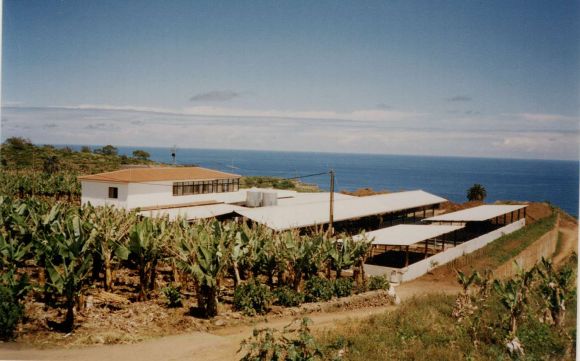
For healthy bananas, I didn’t see any other option, at least at the time, to acquire the necessary amount of natural fertilizer other than establishing our own dairy production. I therefore built up an organic farm at the same time. With this operation, we produced various dairy products and brought these with our own refrigerated truck directly to the stores.
2.11. The nutritional value of bananas
It is well known that people in the West eat too many calories, too much fat, too much protein, and too many denaturated foods. We eat too little fiber and don’t get enough natural, raw foods.
But we hear from many different sources how healthy it is to have fruit regularly as a snack between meals and that eating a piece of fruit as an appetizer can prevent us from consuming too many calories as a result of food cravings.
Bananas are the perfect solution
- They are relatively inexpensive all year round.
- And as they are naturally and hygienically packed in convenient serving sizes and very simple to peel, they are the perfect choice for a healthy snack.
- They make us feel full although they only contain 96 calories per 100 g (about the average size of a banana).
- They taste good even if you eat a lot of them over a longer period of time and they are easy to digest.
Bananas are made up of about 75% water (apples and oranges 85%), 21% carbohydrates, 3% fiber, and 1% protein. In addition, they also contain 0.2% polyunsaturated fatty acids, minerals, and vitamins. Of course, the values do vary a bit.
We were very interested in seeing an analysis comparing our bananas with a brand of popular conventional bananas.
As concerns trace elements, bananas contain more copper than any other fruit or vegetable; they contain more iron than most fruits and have a good level of iodine. They are rich in potassium, phosphorous, and magnesium and have the highest manganese content of any fruit.
At the intermediate enzyme level, manganese is particularly important for carbohydrate metabolism. The way that vitamin B1 is used in the tissues is also dependent on the presence of manganese.
Bananas contain pectin, an important soluble fiber.
And they don’t contain any cholesterol, but instead, only essential unsaturated fatty acids.
Measured as dry weight {dry matter}, bananas are 12% fiber.
They are practically salt-free (only 1 mg sodium per 100 g), have the healthiest sodium bicarbonate-potash ratio (1:1,748) of any fruit, and are free of purines.
They are a highly alkaline food and don’t contain any phytates {phytic acid}.
Bananas contain 0.7 mg oxalic acid, which is ten times less than the amount contained in, for example, strawberries or oranges. Oxalic acid inhibits the absorption of calcium and magnesium.
Although some of its “competitors” contain a superior amount of vitamin C, bananas are considered to be at the top of the group when it comes to classic vitamin values.
Compared to apples, for example, bananas contain five times more vitamin A, vitamin E {tocopherol}, biotin {alt.: vitamin B7 or vitamin H}, and pantothenic acid {vitamin B5}, and 20 times more vitamin B6.
Bananas contain practically no undesirable substances, and only very few people have a food intolerance to bananas.
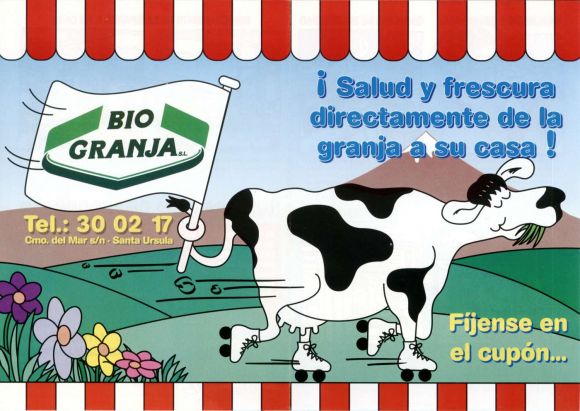 | 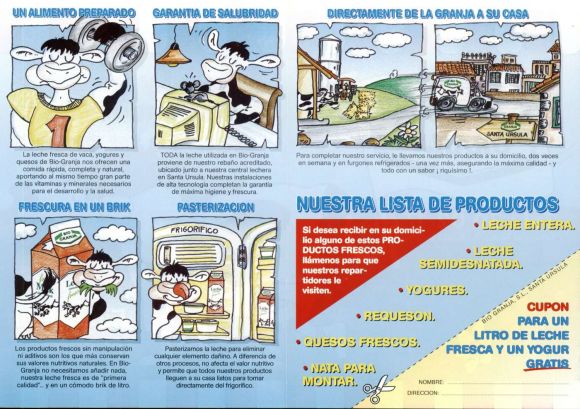 |
These were the advertisements for the first organic products from Tenerife that were sold in stores. As a vegan, this was a turning point, in the sense of a change of direction.
2.12. A closer look at the substances contained in bananas
You know from one of the last letters that scientific analyses have shown bananas to be the healthiest fruit, and you are now familiar with the most important substances found in bananas. We would like to provide you with some data showing average values so that you can compare bananas with other foods.
According to nutritional tables from the Institute of Nutritional Sciences at Giessen University, “normal bananas” contain the following elements (measured in mg per 100 g):
| Potassium | 400 | Calcium | 8 | Phosphorous | 27 | ||
| Magnesium | 36 | Sulfur | 12 | Iron | 0,7 | ||
| Manganese | 0.64 | Copper | 0.2 | Zinc | 0.15 |
Bananas contain all of the classic essential amino acids, and the following are estimated values in mg per 100 g:
| Isoleucine | 32 | Lysine | 46 | Phenylaline | 44 | ||
| Tryptophan** | - | Histidine* | 84 | Leucine | 53 | ||
| Methionine | 22 | Threonine | 38 |
* Histidine is essential for children.
** All values here are from "Ernährungswerte und Diätetik" (Nutritional values and dietetics), volume 3, p.237, Georg Thieme Verlag, and determined using column chromatography (AutoAnalyzer). In the case of tryptophan, no value was determined with the method used, and with other methods a higher value is emphasized.
Essential amino acids and carbohydrates
The above nine amino acids are classically essential, but today we know that only lysine and threonine are really essential (irreversibly transaminated) for healthy people.
Other amino acids contained in bananas: cystine 30 (can be used in place of methionine), tyrosine 29 (can be used in place of phenylamine {aniline}), arginine 84, alanine 50, aspartic acid 118, glutamic acid 104, glycine 47, proline 46, and serine 44 mg per 100 g.

About 90% of the calories in bananas are carbohydrates that are nicely divided into:
- 4.8 g grape sugar (glucose or dextrose) per 100 g,
- 3.7 g fructose (fruit sugar),
- and 12.7 g cane sugar (sucrose).
- In addition, they contain 1.2 g starch.
Glucose is absorbed immediately, fructose somewhat later, and sucrose slowly. The ratio between the different types of carbohydrates in bananas is therefore ideal.
If you assume a comparison with the dry weight of a food, all of the values listed here should be multiplied by four.
Although this letter contains somewhat “dry” material, I believe that it is important to know what you are eating, in particular, if you want to eat a diet that is different from that of the masses. Your doctor may also be able to help interpret this data.
2.13. Do bananas have healing properties?
Bananas are very gentle on the stomach and intestine. This is why you can give infants bananas instead of breast food right from the beginning. Incidentally, did you know researchers now believe that some allergies that develop at a later stage in life are caused by the other types of milk (proteins) infants receive in addition to breast milk in the first days (and weeks) after birth? This finding is still very new and has not yet become common knowledge.
Older people also usually tolerate bananas best.
After this, the medical community shifted to new chemical treatments and is only now beginning to again value properties bananas have when it comes to curing or alleviating certain diseases.
The nutritional value, good tolerance, and healing properties of bananas
Metabolic findings have become available that show the nutritional value {nutrition facts label}, good tolerance, and healing properties of bananas.
- Bananas help work against colitis, and they are given to patients who are exhausted, languid, anemic, or have lost weight.
- Bananas are also recommended in the case of “emotional diarrhea.”
- The serotonin contained in bananas is very well a reason why bananas are used for all bleeding diseases of the gastrointestinal tract (also for colitides and typhoid bleeding).
- The high alkalinity {base excess} of bananas is also helpful.
- In addition, they promote the "growing" of gram-positive gut flora. The pectin in bananas is thought to help enrich the gut flora with acidophilus bacteria.
- Additional substances in bananas help in the case of gastritis and gastroenteritis (gastrointestinal catarrh), celiac sprue, and also duodenal ulcers (Ulcus duodeni).
According to Archiv für Kinderheilkunde (Archive for pediatrics) (Volume 166, Issue 1, 1962, Ferdinand Enke Verlag), there have been excellent results using bananas to treat celiac disease (allergy to gluten, a protein composite found in wheat and rye).
Fructose continues to be metabolized even when the pancreas is damaged by diabetes or alloxan poisoning or the liver by hepatitis or phosphorous poisoning.
When you, for example, have a fever, are hungry, or are under anesthetic, glucose metabolism is impaired, whereas fructose activity remains consistent.
- Fructose has a protein-saving effect and can prevent potassium losses that often occur during stress. The potassium-sugar combination in bananas is ideal for a diet aimed at correcting a mineral deficiency.
Bananas have also been successful as a treatment for certain neurological diseases.
Based on the substances contained in bananas, it is evident that they can play an important part in a diet that is to treat gout, high blood pressure, coronary diseases, and many other diseases as well. Bananas are also well tolerated by most patients before and after an operation.
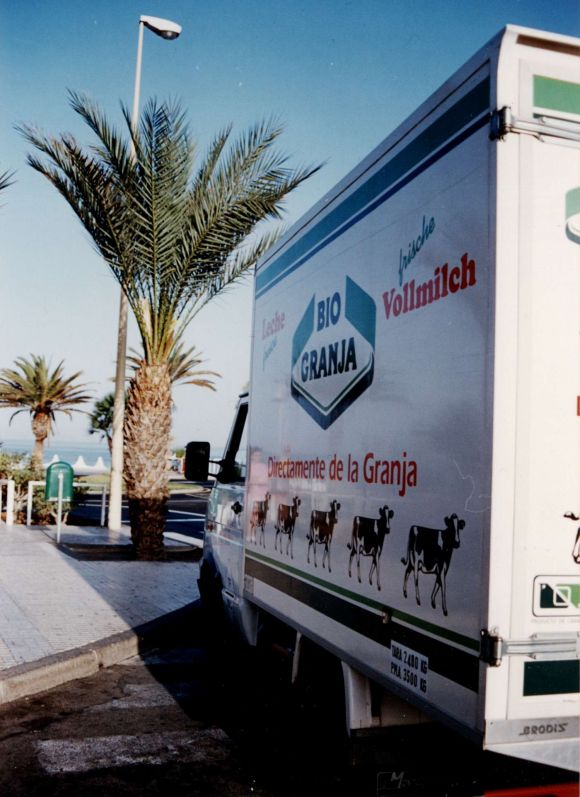 | 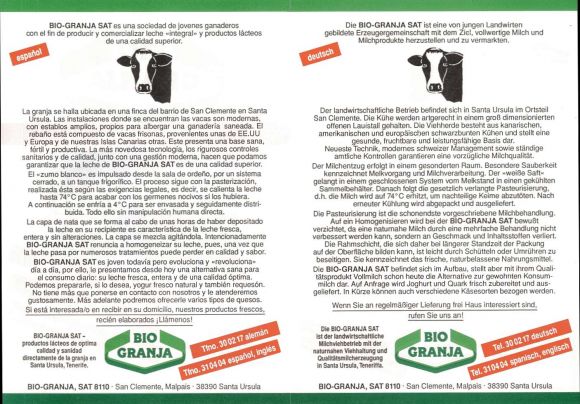 | 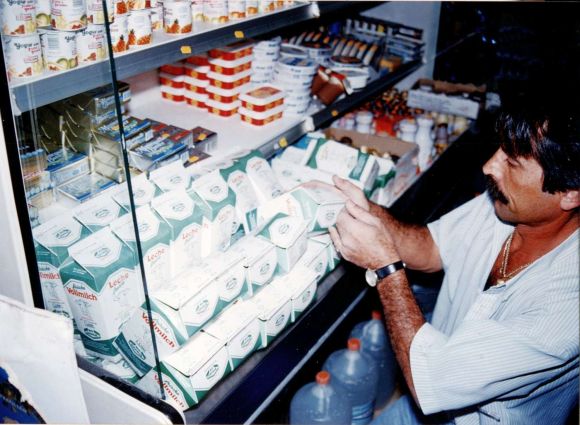 |
2.14. Specific results showing the value of bananas
I wasn’t able to fully do justice to the healing properties of bananas as there is so much to say about the topic. There are many reports on the successes attained by using bananas as treatment, and although it would be too much to discuss all of these here, it is well worth our time to look at the following.
- Bananas have proven to be effective in cases of allergic eczema and food allergies.
- For obesity, a diet consisting of only bananas and skim milk (940 cal per day) has been shown to be very successful. After two weeks, light meals and several types of fruit can also be tolerated.
- Bananas can play a central role in the diet of diabetics, in particular, when they are eaten together with cream since the sugar then enters the bloodstream rather slowly.
- They are also used as treatment for metabolic disorders such as gout and for nephritis.
- The high proportion of vitamins B1, B2, B6, and biotin is believed to prevent graying hair {hair color} and hair loss.
- According to a notice in the Neue Zürcher Zeitung (Swiss newspaper) on July 7, 1984 (p. 45, research and technology section), a research program at Aston University confirmed that raw plantains contain a substance that is more effective in treating stomach ulcers than most of the medications used to date. This, however, only applies to raw plantains.
The optimal amount of protein
The optimal amount of protein per day and kilogram (2.2 pounds) of body weight is 0.34 g. To be safe, recommendations are usually made at 0.5 to 1 g per day and kilogram of body weight. This comes to 35 to 70 g per day for people with a normal body weight.
Hegstedt showed that adults must consume at least 3.2 g of the best protein for the essential amino acids. Other researchers have concluded that we should ideally consume 10 to 15 g of protein per day.
Just over 3 pounds (peeled) of bananas (1.5 kg) contain 18 g of ideal protein. And the same amount covers almost all of our vitamin requirements.
Bananas also contain enough of all of the trace elements except for calcium and phosphorous. And they don’t contain the fatty acids we need.
Just by consuming two slices of cheese (50 g), a carrot, and a few nuts in addition to the bananas would cover our requirements for a number of other substances. The cheese can be replaced by ¾ cup hazelnuts (200 g) and some chives or parsley.
These findings shouldn’t be viewed as a new diet recommendation, but should instead make it clear just how valuable bananas are when it comes to essential substances. And it explains why several groups of people are able to live on a diet consisting of 50 to 90% bananas and why milk and dairy products go perfectly with bananas.
In spite of these facts, in Europe the average person eats only 15.5 to 20 pounds (7 to 9 kg) of bananas per year. But they eat five times more sugar, over ten times more meat, and drink the same amount in pure alcohol. Cheers!
2.15. Recipes with bananas
Bananas can be prepared in a variety of ways and taste great in combination with other types of fruit. They enhance fruit salads and mixed drinks and can be baked, deep fried, dried, or cooked, and served sweetened or salted. Bananas have a different flavor at each stage of ripeness.
Here are a few simple recipes to try out:
Banana Milkshake
Ingredients: 4 cups of milk, 4 peeled bananas, and lemon juice
Preparation: Mix the bananas and milk with a dash of lemon juice in a blender. Add a little honey, if desired.
Banana Ice Cream
Ingredients: 4 bananas, 1¼ cups whipping cream (250 g), ¼ cup honey (80 g), and lemon juice
Preparation: Finely mash the bananas with a fork and then beat until fluffy. Add the lemon juice and honey. Beat the whipping cream until stiff and then fold into the banana mixture. Place in the freezer in a suitable container.
Banana Quark
Ingredients: 2¼ cups low-fat quark (500 g), 1¼ cups buttermilk (250 g), 4 ripe bananas, lemon peel, 4 tablespoons lemon juice, 2 tablespoons honey, and 2 pinches cinnamon
For garnish: 2 bananas and 2 tablespoons lemon juice
Preparation: Beat the low-fat quark and buttermilk until fluffy, grate the lemon peel, and add this and the cinnamon to the mixture. Mash the bananas with a fork and then beat together with the lemon juice and honey until fluffy. Combine this mixture with the quark. Serve chilled.
Garnish: Slice the bananas, drizzle lemon juice on top, and then arrange on top of the quark. Serve chilled.
Banana and Avocado Spread
Ingredients: 1 ripe avocado (peeled, pit removed, and finely puréed), 1 tablespoon lemon juice, ½ ripe banana (puréed), ¼ cup wheat germ, and 2 tablespoons coarsely chopped walnuts
Preparation: Combine all of the ingredients to make a thick mixture and then spread this on buttered slices of bread. The recipe should be enough for 4 slices.
You can use a blender to make any number of fruit smoothies and adding banana enhances their flavor. There are other fruits you can also add such as oranges with lemon. Banana works well with many cooked dishes. Add it, for example, to sole or other fish filets and to curry rice.
2.16. Erb Muesli — recipe with sprouted grains
In 1978, I created a muesli that over time has come to be appreciated by a growing number of people.
Both rolled oats and wheat bran are heat-treated during the manufacturing processing. This is why they aren’t used in “my” muesli.
The grains are finely ground in a suitable manual grain mill shortly before the muesli is served. It is quicker to use an electric coffee grinder, but this is a less gentle method.
Erb Muesli — recipe with sprouted grains
Ingredients for 1 serving:
- 3-4 tablespoons ground grains (e.g., millet/flaxseed, buckwheat, and oats), with added anise, vanilla, or other spice (if desired)
- 2 tablespoons sprouted grains (30 g) (after sprouting, 60 g)
- 2 oranges, freshly squeezed, with pulp (approx. 150 g)
- 1/2 lemon, freshly squeezed, with pulp (approx. 25 g)
- 2-3 tablespoons ground hazelnuts, almonds, or other nuts (20 g)
- 2 bananas, mashed with a fork (approx. 250 g)
Preparation: Place the freshly ground grains, nuts, spices (if using), and spouted grains in a bowl. Add the freshly squeezed orange and lemon juice (you might prefer to use half of the amount specified for the lemon).
If oranges aren’t available, you can use a fruit juice such as acerola juice from Donath, some blueberry juice, or a dairy product. Add the bananas and mix well.
Garnish with berries or fruit slices (e.g., kiwi), and your muesli is perfect. It will taste delicious every day.
Notes: When you are grinding the grains, you can add a little anise or star anise, vanilla, or other suitable flavor, or you can use a little cinnamon.
In place of freshly squeezed oranges or as an extra addition, you can add a portion of fermented milk (such as buttermilk), cultured milk (soured milk, popular in Europe), or yogurt (organic yogurt).
You should eat the muesli directly after preparing it so that as few vital substances as possible are destroyed. The more valuable that a food is for cell structure and our performance (i.e., energy levels and productivity), the more quickly it goes bad after it is extracted from its natural environment through processing.
It is best to buy a BioSnacky seed sprouter or other type of special plastic container for sprouting.
Fill one tray and it will yield about 60 g, which is enough for two people. Pour about ½–1 inch (1–2 cm) lukewarm drinking water in the tray and make sure that the water drains down through the tray. At normal room temperature, the grains will be sprouted just right in 24 hours, and you can then start a new batch every morning.
Organic, sproutable grains, for example, sproutable barley, rye, or wheat from Donath or Demeter work well and contain very few pieces of grit.
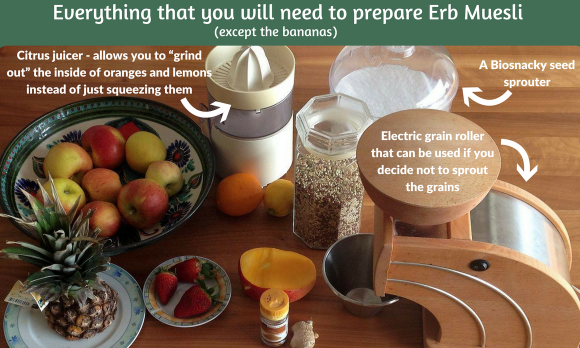
You can find detailed information here about these three varieties of Erb Muesli: (1) the basic form, with sprouting as is described above, (2) without sprouting, and (3) a gluten-free version.
By eating a GFGF diet, you can experience significant improvement with a variety of diseases. For more information on the topic, I recommend that you read this article.
2.17. More information about the basic recipe
When Dr. Bircher developed his muesli (milk, rolled oats, and grated apples), the ingredients it called for were still sold as raw foods. Today, however, it is practically impossible to buy raw milk or rolled oats in their natural state. However, for Erb Muesli, you don’t need any of these ingredients. And bananas and sprouted grains (not seedlings!) are particularly valuable foods.
It is very rich in vital substances and meets a large portion of your daily requirements for (essential) substances, including vitamins and minerals. And it contains ample fiber. It only takes about 10 minutes to both make the muesli and start a batch of sprouting grains for the next day.
A few extra comments
A few extra comments are necessary here.
- The sprouts on the grains should only be about ½–1 inch (1–2 mm) long; at that point, the grains contain the greatest amount of “life energy,” which can be shown on the basis of the “life acids” (e.g., lactic acid and malic acid) (see Geschwülste (Tumors), Dr. Kuhl, Humata Verlag, p. 43).
- Sproutable rice is also a good option, but the sprouting process takes two to three times longer.
- It is important to make sure that the water drains down through the tray. If it doesn’t, the grains will start to rot instead of sprout. In principle, the same thing happens with coarsely ground and fermented grains. Here is life and there is death. If you feel a cold coming on, add a little honey to your muesli.
- Seven almonds or hazelnuts weigh about 10 g. You can use nuts, sunflower seeds, sesame seeds, and other seeds to vary the flavor. I recommend that you add some pumpkin seeds.
- You can control the amount of calories by increasing or decreasing the number of nuts. The muesli tastes more savory when the nuts aren’t chopped or aren’t chopped too finely. You should never buy nuts or almonds in pieces or chop them to use the next day as they will oxidate.
- If you are in a hurry or if you don’t care if these products are denatured, you can use ¼ cup bran (15 g) or rolled oats instead of freshly ground grains.
Erb Muesli more than meets the daily requirement for Vitamins C and E. Of the 15 grams of fat, about 5 grams consist of polyunsaturated fatty acids (PUFAs). Half of the daily requirement for PUFAs is therefore also covered. The purine content (in uric acid) comes to only about 15 mg. The exact details on nutritional values and also vitamins and minerals will be explained in detail in the next letter.
This muesli has now been my favorite food for over 10 years now. I have even made in the Algerian desert, although I did bring the bananas with me from abroad. By varying the freshly ground ingredients and the fruit, Erb Muesli tastes new and fresh every day.
2.18. Ingredients in the classic Erb Muesli
After reading and thinking about Erb Muesli, you probably now understand why I went to such lengths to be able to grow my own organic bananas. Here is a table with data on the substances contained in the muesli. I have left out some of the ingredients, such as pumpkin seeds, flaxseed, millet, honey, and flavorings as I wasn’t able to find the relevant information.
For those of you who use wheat bran, these figures are listed under the totals. The variations containing dairy products are shown with the example of homemade yogurt. Explanations to come.
Nutritional value and vitamins
1. Nutritional value
| Product | Net grams | Cal. | Protein | Fat | Carb. | Water | Fiber |
| Wheat, sprouted | 60 | 111 | 8.0 | 2.7 | 13.8 | 33.5 | 0.7 |
| Bananas | 250 | 241 | 2.7 | 0.5 | 56.3 | 187.0 | 1.5 |
| Oranges | 150 | 80 | 1.5 | 0.3 | 18.0 | 129.0 | 0.9 |
| Lemons | 25 | 9 | 0.1 | 0.1 | 2.0 | 22.8 | 0.1 |
| Hazelnuts | 10 | 65 | 1,.3 | 6.1 | 1.4 | 0.6 | 0.1 |
| Almonds | 10 | 64 | 1.9 | 5.3 | 1.9 | 0.5 | 0.2 |
| Total | 505 | 570 | 15.5 | 15.0 | 93.4 | 373.4 | 3.7 |
| Wheat bran | 15 | 52 | 2.3 | 0.3 | 3.0 | 0.7 | 8.0 |
| Yogurt | 300 | 204 | 11.7 | 11.4 | 13.8 | 87.0 | -.- |
Contains 650 calories.
2. Vitamins
| Product | A/µg | E | B1 | B2 | Niacin | C |
| Wheat, sprouted | 48.0 | 8.2 | 0.60 | 0.21 | 1.35 | -.- |
| Bananas | 95.0 | 1.3 | 0.12 | 0.15 | 1.75 | 27.5 |
| Oranges | 22.5 | -.- | 0.14 | 0,.06 | 0.60 | 75.0 |
| Lemons | 1.0 | -.- | 0.02 | 0.01 | 0.05 | 25.5 |
| Hazelnuts | 0.4 | 2.1 | 0.04 | 0.02 | 0.14 | 0.3 |
| Almonds | 2.3 | 1.5 | 0.03 | 0.09 | 0.35 | -.- |
| Total | 169.2 | 13.1 | 0.95 | 0.54 | 4.24 | 128.3 |
| Daily requirement | 700–900 | 12.0 | 1.00 | 1.50 | 9–15 | 75 |
| Comp. with 3 yogurts | 96 | 0.9 | 0.12 | 0.54 | 0.30 | 3 |
Vitamin A (retinol equivalent) is listed in micrograms, and all of the other vitamins in milligrams. Vitamin E as a tocopherol equivalent, B1 = thiamine, B2 = riboflavin, C = ascorbic acid
The data on minerals and some additional comments follow in the last letter about Erb Muesli. I would be happy to hear how you like the muesli and what changes you see in yourself as a result of eating it. Thanks!
2.19. How to we maintain our ideal weight and what is this?
For those who are between 5'3" and 5'10" (160–180 cm), the “biological ideal weight” is calculated by taking your height in centimeters and subtracting 100 and then subtracting 15% (10% for males).
If a person weighs 10% more than this biological ideal weight, their life expectancy is shortened by 15% and if they weigh 20% more, it is shortened by 40%. And those who are overweight often have reduced mobility and quality of life. Now here is the last set of data for the muesli.
Minerals in Erb Muesli
Minerals in mg *
| Product | Sodium | Potassium | Calcium | Phosphorous | Magnesium | Iron |
| Wheat, sprouted | 1.8 | 293 | 24 | 385 | -.- | 2.84 |
| Bananas | 2.5 | 955 | 20 | 68 | 90.0 | 1.75 |
| Oranges | 1.5 | 284 | 63 | 33 | 21.0 | 0.60 |
| Lemons | 1.0 | 71 | 6 | 6 | 0.5 | 0.10 |
| Hazelnuts | 0.2 | 63 | 23 | 33 | 15.0 | 0.38 |
| Almonds | 0.3 | 69 | 23 | 50 | 25.2 | 0.47 |
| Total | 7.3 | 1735 | 159 | 575 | 151.7 | 6.14 |
| Daily requirement | ** | 2500 | 800 | 800 | 260 | 10–18 |
| Comp. with 3 yogurts | 144 | 471 | 360 | 276 | 36 | 0.30 |
* The mineral amounts are listed in milligrams. Erb Muesli contains 0.084 mg fluoride (as potassium fluoride) or more if the drinking water contains fluoride (sodium fluoride). As protection for our teeth, certain groups recommend that we get 1 mg of fluoride daily.
** Erb Muesli contains practically no salt and can be integrated into low-salt diets (e.g., to lower high blood pressure).
Getting all of the essential substances you need and being able to successfully lose weight
If you eat the muesli, some dairy products, carrots, and some parsley or chives and drink plenty of water or herbal teas (2 liters), you will be getting all of the essential substances you need and will be able to successfully lose weight.
Prevention is indeed better than early diagnosis! Most (popular) weight-loss diets are unbalanced or make use of the fact that to convert protein, virtually the same amount of energy must be used as is taken in as calories. Both of these types of diets can be dangerous.
About 1½ cups of carrots (200 g) contain 2,200 µg of carotene (and 1.4 mg iron) and meet our daily requirements for vitamin A even if metabolism is low.
Iron deficiencies are quite common for people who eat a pure plant-based diet. Our iron levels are usually at 4 to 5 g, but each day we excrete 1 to 1.5 mg, and when we bleed even more.
The reabsorption rate is on average 10% (with meat 30%), which means that we should consume 10 to 18 mg per day. One bunch of chives (100 g) contains 13 g, two small bunches of parsley (100 g) have 8 grams, and just over 1 cup sesame seeds (100 g) contains 10 mg of iron.

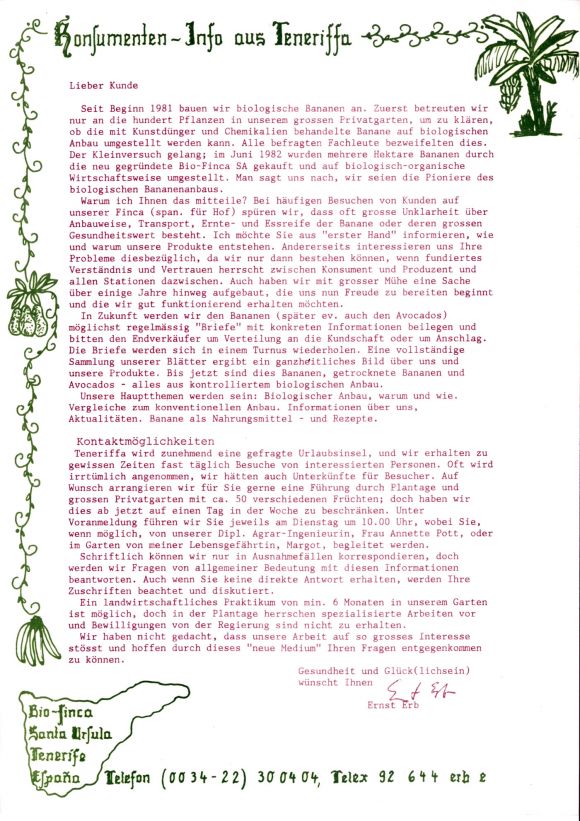
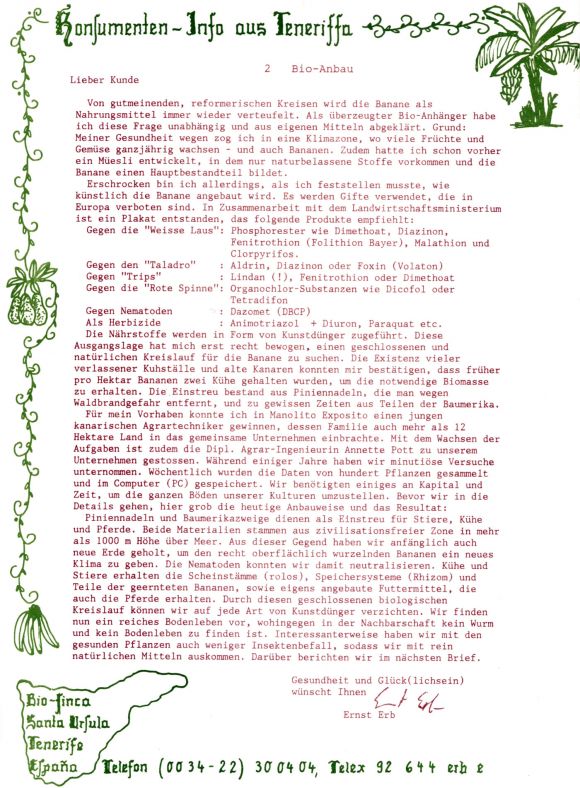
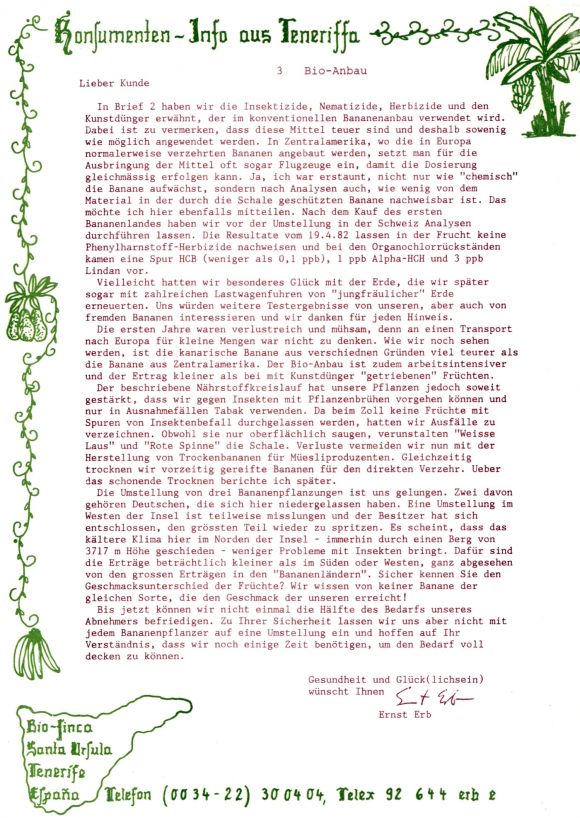
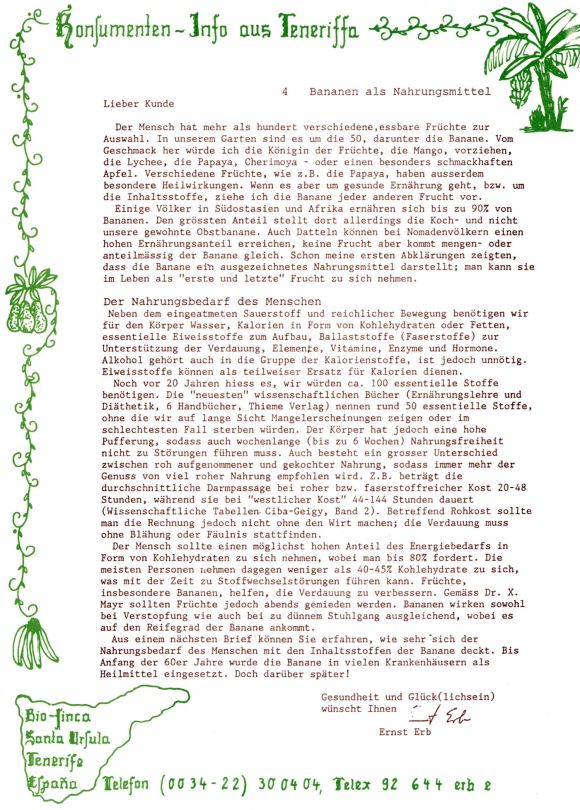
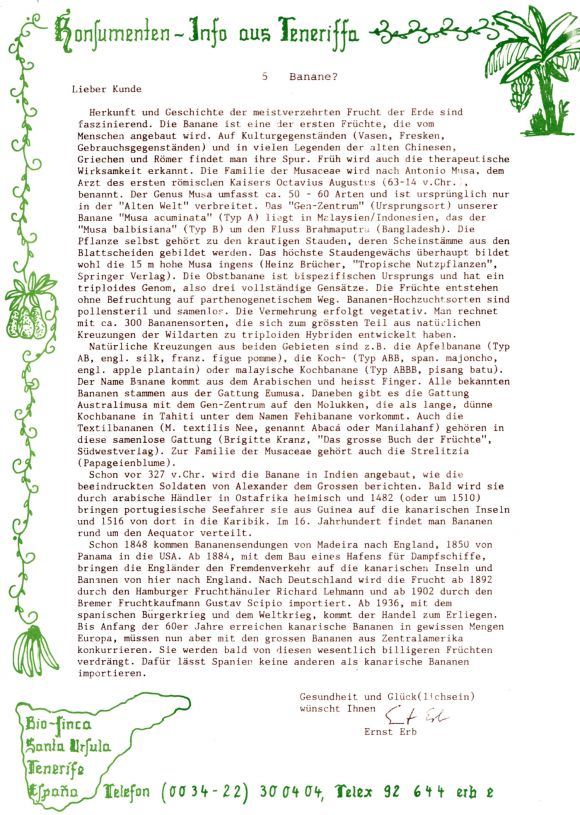
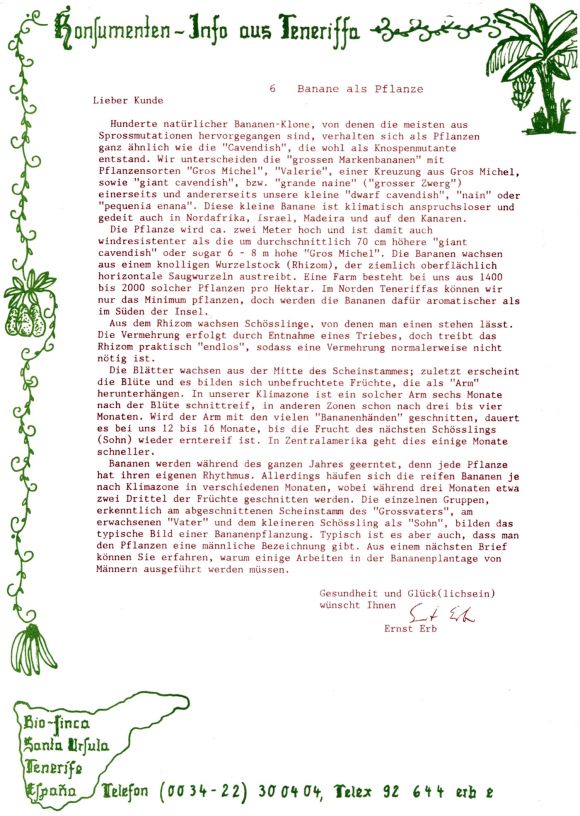
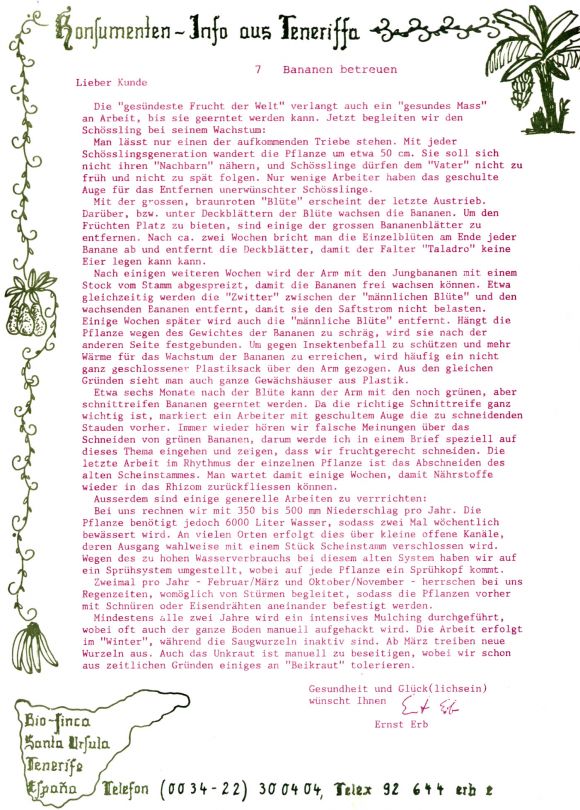
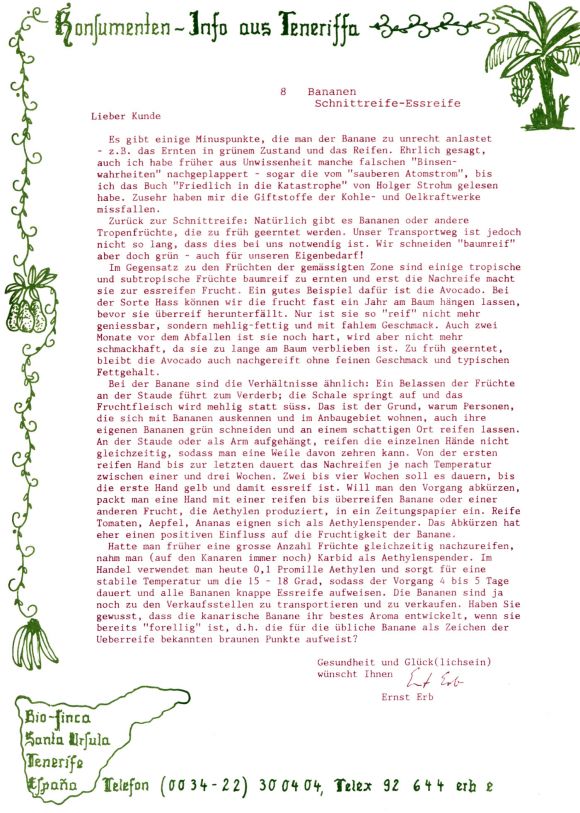
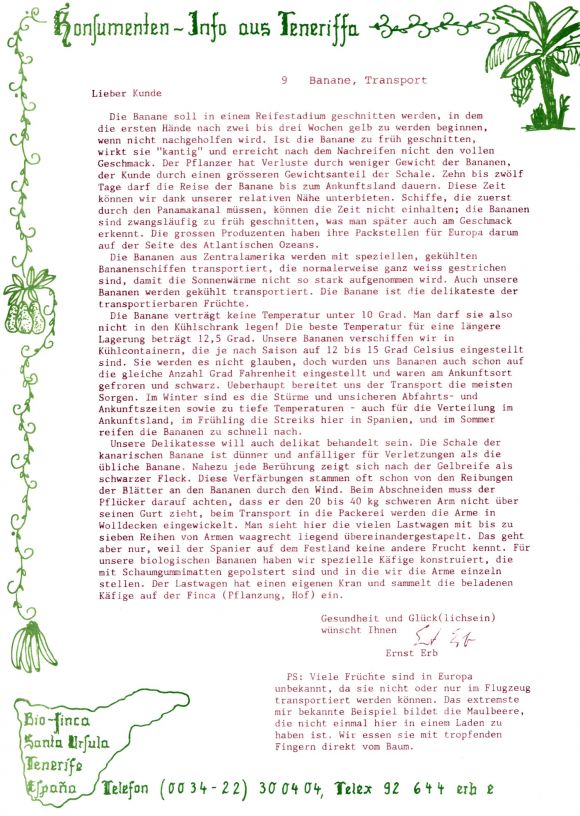
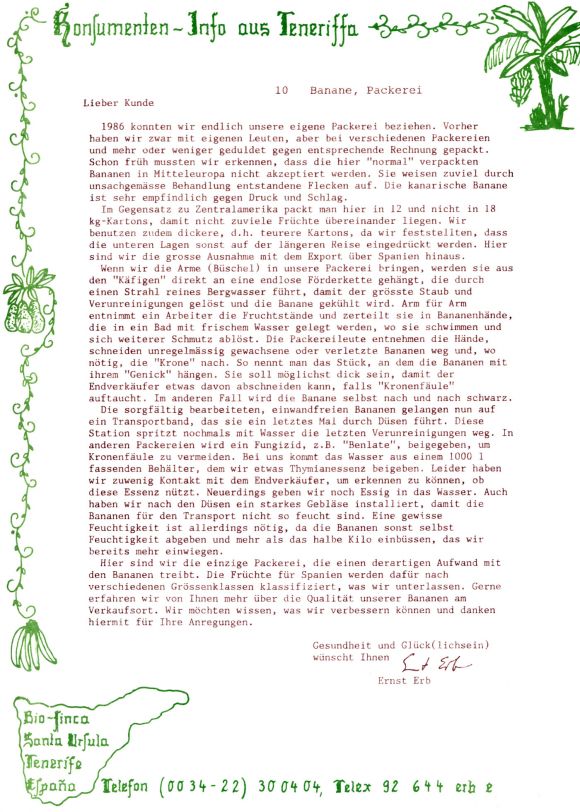
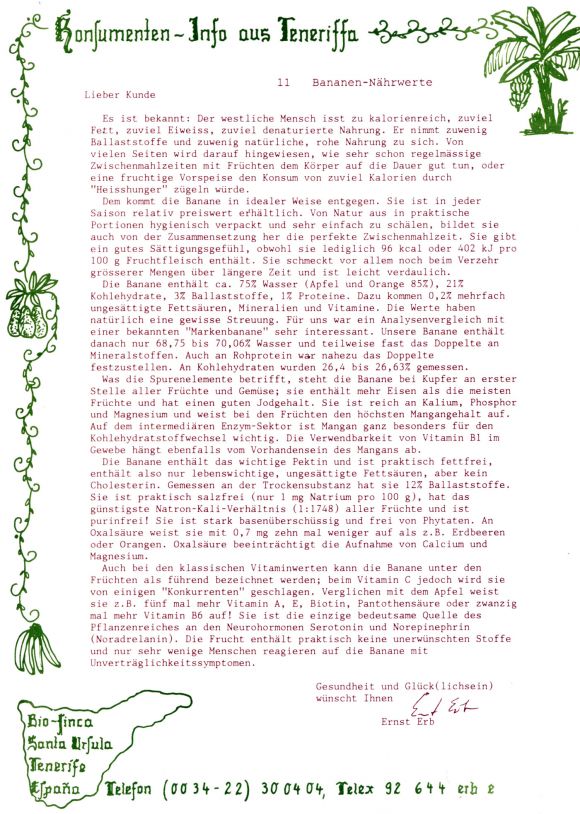
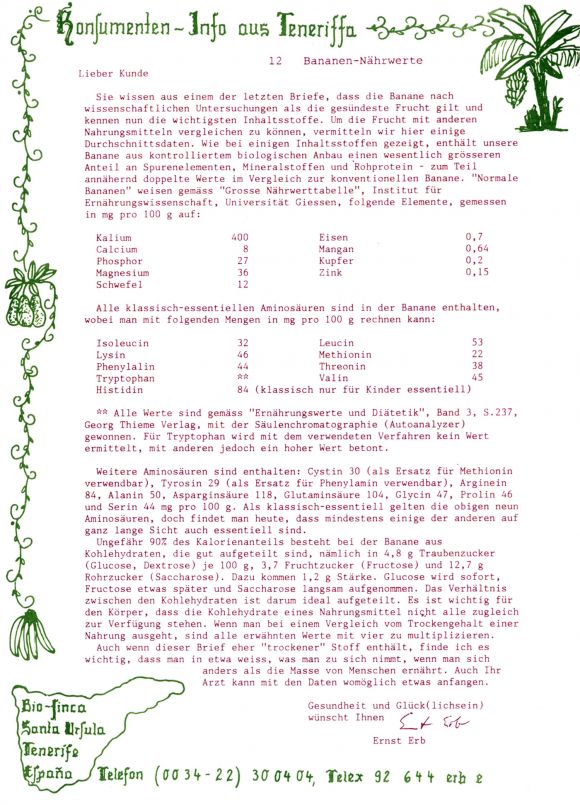
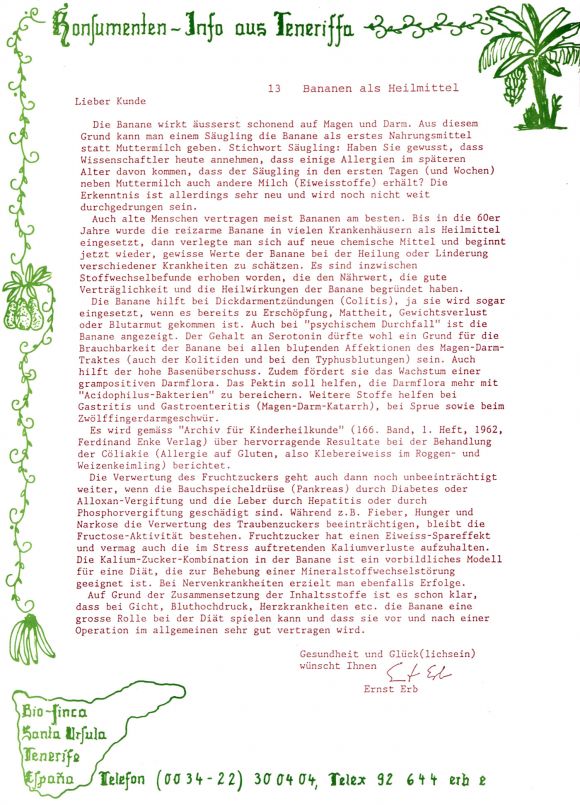
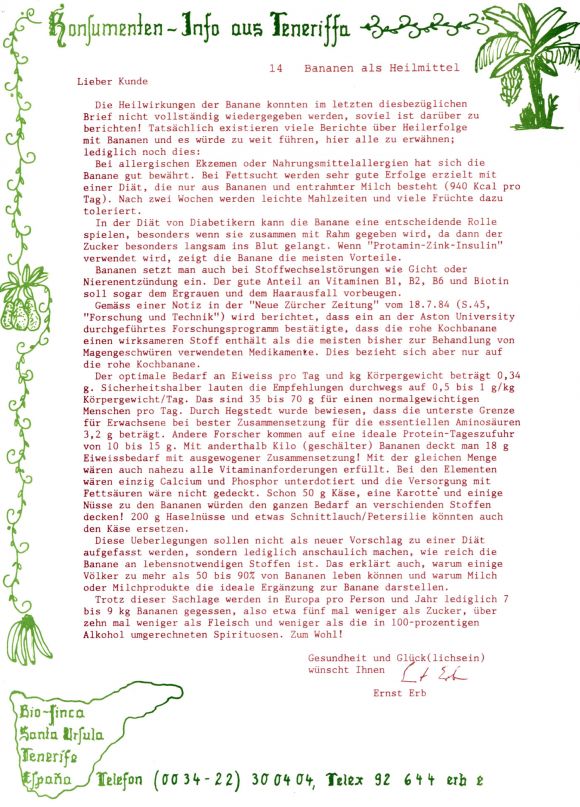
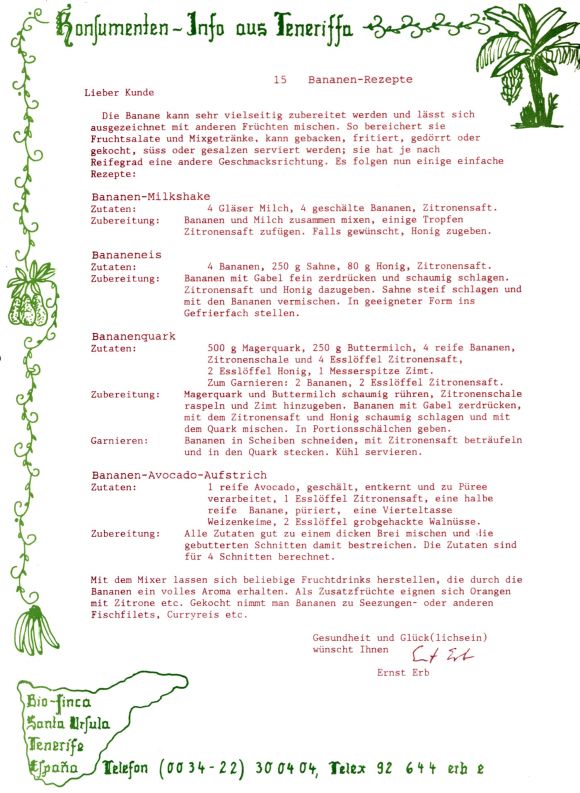
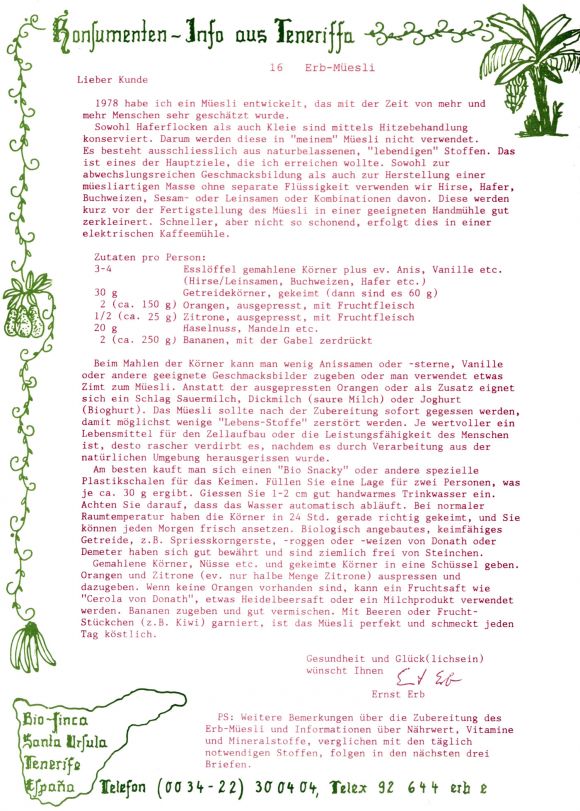
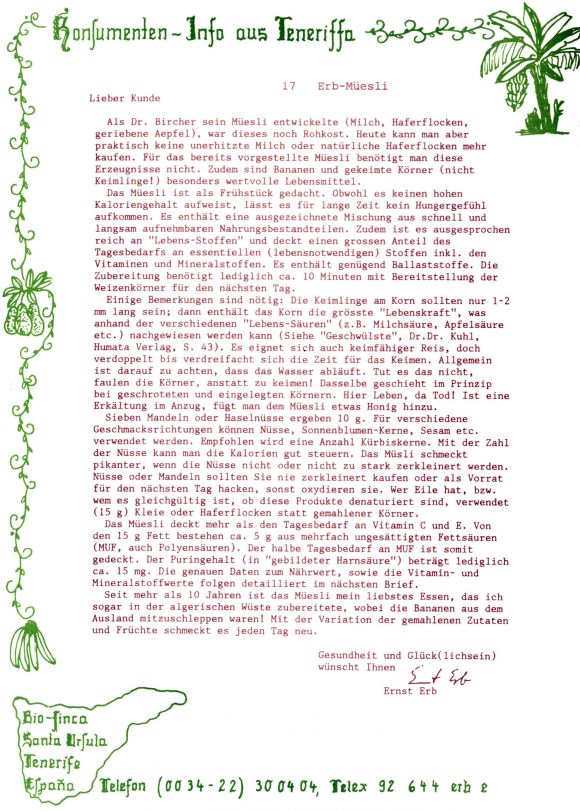
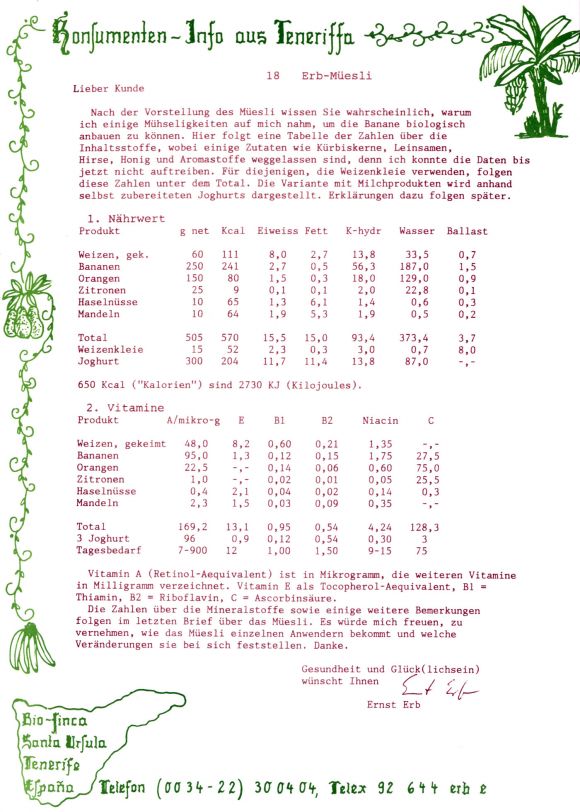
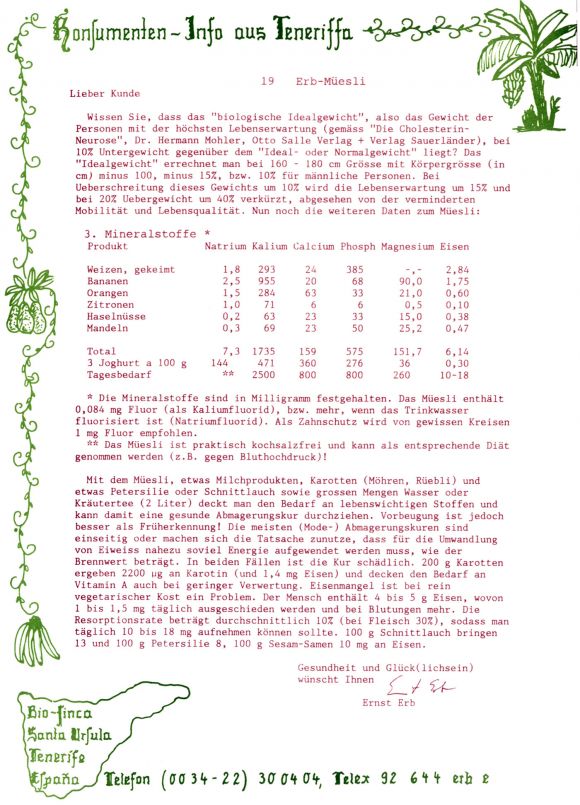
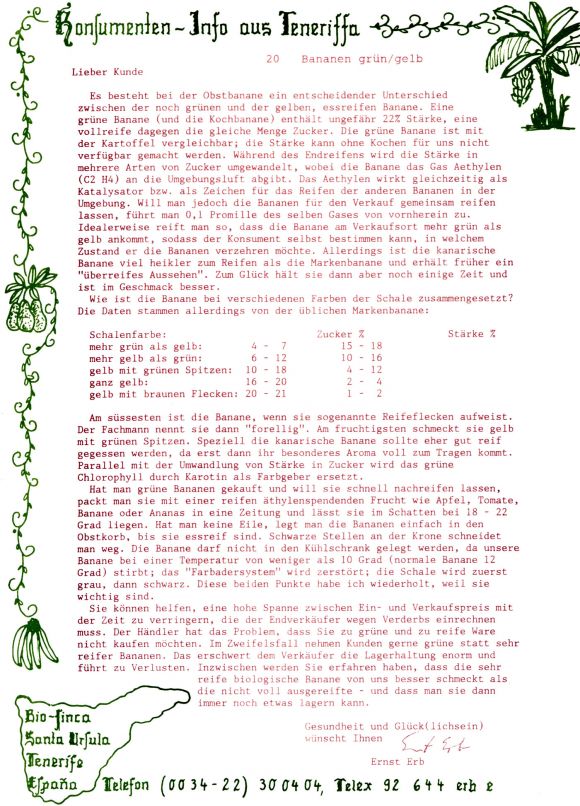
Comments